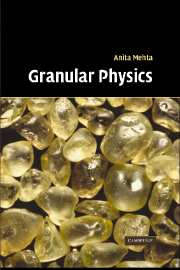Book contents
- Frontmatter
- Contents
- Preface
- 1 Introduction
- 2 Computer simulation approaches – an overview
- 3 Structure of vibrated powders – numerical results
- 4 Collective structures in sand – the phenomenon of bridging
- 5 On angles of repose: bistability and collapse
- 6 Compaction of disordered grains in the jamming limit: sand on random graphs
- 7 Shaking a box of sand I – a simple lattice model
- 8 Shaking a box of sand II – at the jamming limit, when shape matters!
- 9 Avalanches with reorganising grains
- 10 From earthquakes to sandpiles – stick–slip motion
- 11 Coupled continuum equations: the dynamics of sandpile surfaces
- 12 Theory of rapid granular flows
- 13 The thermodynamics of granular materials
- 14 Static properties of granular materials
- References
- Index
- Plate section
3 - Structure of vibrated powders – numerical results
Published online by Cambridge University Press: 06 October 2009
- Frontmatter
- Contents
- Preface
- 1 Introduction
- 2 Computer simulation approaches – an overview
- 3 Structure of vibrated powders – numerical results
- 4 Collective structures in sand – the phenomenon of bridging
- 5 On angles of repose: bistability and collapse
- 6 Compaction of disordered grains in the jamming limit: sand on random graphs
- 7 Shaking a box of sand I – a simple lattice model
- 8 Shaking a box of sand II – at the jamming limit, when shape matters!
- 9 Avalanches with reorganising grains
- 10 From earthquakes to sandpiles – stick–slip motion
- 11 Coupled continuum equations: the dynamics of sandpile surfaces
- 12 Theory of rapid granular flows
- 13 The thermodynamics of granular materials
- 14 Static properties of granular materials
- References
- Index
- Plate section
Summary
A microscopic description which focuses on the essential discreteness of grains is a fundamental part of understanding many fascinating features of a granular medium. Its response to vibration can be understood in terms of the competition between individual-particle and cooperative dynamical mechanisms intrinsic to the grains in a disordered assembly. We present below computer simulation results for some features of granular structure which depend only weakly on details of grain size or material, e.g. the finite range for the packing fraction or shaking-induced size segregation.
Details of simulation algorithm
In this section, we describe the details of the simulations first reported in. Simulations are performed for a bed of monodisperse hard spheres above a hard base at z = 0. The granular bed is periodic, with a repeat distance of L sphere diameters in two perpendicular directions x and y in the plane. Each primary simulation cell contains N spheres. A unidirectional gravitational field acts downwards, i.e. along the negative z-direction. Initially, spheres are placed in the cell using a sequential random close-packing procedure; the packing is then subjected to a series of nonsequential N-particle reorganisations. Each reorganisation is performed in three parts: first, a vertical expansion or dilation, second, a Monte Carlo consolidation, and finally a nonsequential close-packing procedure. We call each full reorganisation a shake cycle or, simply, a shake. The duration of model shaking processes as well as the lengths of other time intervals are measured in units of the shake cycle.
- Type
- Chapter
- Information
- Granular Physics , pp. 27 - 51Publisher: Cambridge University PressPrint publication year: 2007
- 1
- Cited by



